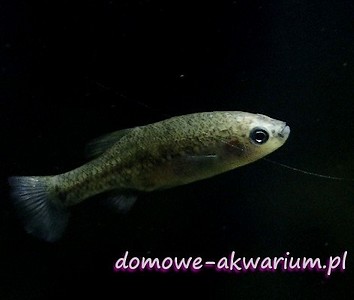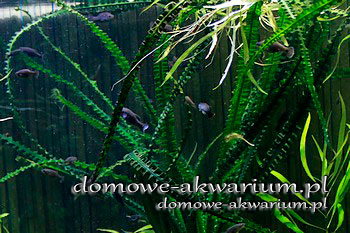
| Gatunek | Tequila Splitfin |
|---|---|
| Nazywany też | Tequila Pupfish |
| Nazwa łacińska | Zoogoneticus Tequila |
| Rodzina | żyworódkowate |
| Występowanie | Ameryka Środkowa |
| Długość | 6 - 7 cm |
| Temperatura | 20 - 26°C |
| Twardość wody | medium hard |
| pH | 6.5 - 7.5 |
| Zbiornik | 100 L |
| Pokarm | live, frozen, dry |
Tequila Splitfin, Tequila Pupfish
This freshwater species is endemic to the surroundings of the Tequila volcano in Mexico. In natural conditions, it inhabits the shallow waters of lakes, ponds, streams and surrounding tributaries, although it is currently considered extinct in the wild. This species is critically endangered.
The species is characterized by an olive-black body color, with black fins. The male can be identified by a more slender build, a yellowish margin at the tips of the fins, and a broad yellow-orange stripe at the edge of the caudal fin. The male also has an andropodium - a copulatory organ formed from transformed, shortened anterior rays of the anal fin. The andropodium is separated by a notch from the rest of the anal fin. Females are a bit larger than males, with an olive-gray body color and fins, and lighter underneath.


This fish is active, sociable, curious and lives in groups. It is moderately aggressive – especially pregnant females, females to males, and males among themselves, who establish a hierarchy. The dominant male is always the most brightly colored. This species is a predator. It mainly feeds on invertebrates – small crustaceans and insect larvae. This fish should be kept in a species-only or general aquarium with dwarf cichlids from Central America.
These fish feel well in an aquarium with a lot of plants, hiding places among roots, stones and rocks, with a gravel substrate and slightly scattered light. The darker the environment, the darker the fish's coloring. Oxygen-rich water, effective filtration and regular partial water changes are essential.

Live-bearing species. Fish reproduce easily in a common tank with a large amount of plants. Courtship precedes spawning. The female is fertilized internally, and a fertilized female does not have a characteristic pregnancy spot on her body around the anus. Pregnancy lasts about 65 days, after which fry of quite large size (1.0-1.5 cm) appears gradually - about 5-20 pieces. Initially, the fry stays close to the water surface, but its feeding should be started immediately after it appears. Parents do not take care of the fry and can eat offspring. The female does not store the male's sperm, as other live-bearing species do - therefore a male is necessary for successful breeding, in order to raise the next brood.